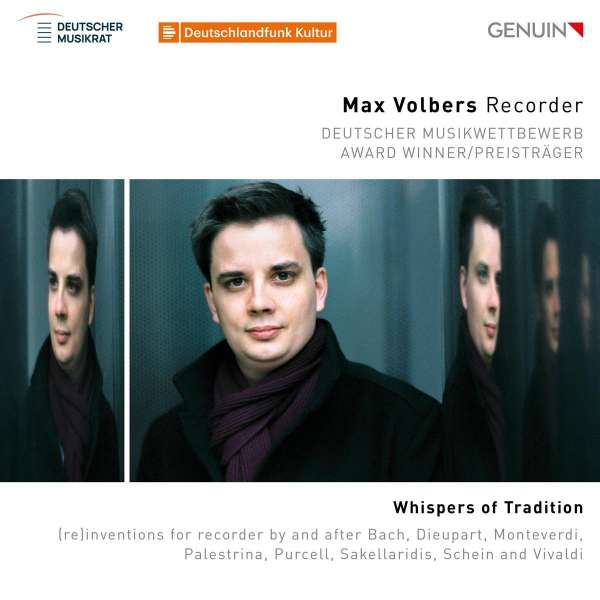Max Volbers, Gewinner des Deutschen Musikwettbewerbs 2021, stellt Werke für Blockflöte vor, die von den überlieferten Anfängen bis zum Barock reichen. Mit Please Enter the Underground von Thanos Sakkelaridis mischt er ein Werk jüngeren Datums bei, das noch andere Ausdrucksmöglichkeiten für das Instrument bietet.
Er stellt seine Auswahl unter den Titel Inventionen, also der von einer vorgestellten Idee ausgehenden Ausarbeitung derselben. Das stellt sich hier so dar, dass er Stücke für sein Instrument transkribiert, also für das eigene Instrument spielbar gemacht hat. Dabei bettet er die Blockflöte zwischen Duo und Ensemble in unterschiedliche Kontexte. Im Duo ist das moderne Werk zu hören, das für zwei Paetzold-Flöten, also eckige Instrumente geschrieben ist und den Klängen bis zu heutigen Grooves, also der heutigen Form des Ostinato, folgt.
Somit hat Volbers sich nicht nur Großes vorgenommen, sondern es gelingt ihm auch, diese Herausforderung in eine vielschichtige Darstellung seiner Ideen umzusetzen. Auch als Cembalist und Dirigent aktiv, beabsichtigt er, wie früher üblich, mehrere Instrumente zu beherrschen. Jedenfalls gelingt ihm für die Flöten eine mehr als ansprechende Sammlung seiner Umsetzungen. Mag auch sein Spiel hier und da ein wenig spitz klingen oder auch mal der Schein gegeben sein, dass er technisch gefordert ist, so tut das dem inspirierten Zuhören keinen Abbruch. Vielmehr überwiegt der Eindruck, einen ebenso agilen wie versierten Musiker lauschen zu dürfen, der nicht nur Noten nachspielt, sondern seine eigenen Gedanken einbringen kann.
Seine Begleiter, auch in der Alten Musik erfahrene Musiker, tragen diese Ideen mit und sind hingebungsvoll in die Präsentation eingebunden. Neben dem informativen Beiheft ergänz die sehr präsente Aufnahmetechnik dieses Porträt des Künstlers.
Max Volbers, winner of the 2021 German Music Competition, presents works for recorder ranging from the beginnings to the Baroque. With ‘Please Enter the Underground’ by Thanos Sakkelaridis, he adds a recent work that offers other expressive possibilities for the instrument.
He places his selection under the title of Inventions, i.e. the elaboration of an idea that has been presented. He has transcribed pieces for his instrument, i.e. made them playable for his own instrument. In doing so, he embeds the recorder in different contexts between duo and ensemble. The modern work is written for two Paetzold flutes, i.e. angular instruments, and follows the sounds up to today’s grooves, i.e. today’s form of the ostinato.
With this program, Volbers has not only set his sights on great things, but he also succeeds in translating this challenge into a multi-layered presentation of his ideas. Also active as a harpsichordist and conductor, he intends to master several instruments, as it was common in the past. In any case, he succeeds in a more than appealing collection of his realizations for the flutes. Even if his playing may sound a little sharp here and there, or even if there is sometimes the appearance that he is technically challenged, this does not detract from the inspired listening. Rather, the impression prevails that one is listening to a musician who is as agile as he is accomplished, who does not just play notes, but who can contribute his own thoughts.
His accompanists, also musicians experienced in early music, carry these ideas along and are devotedly involved in the presentation. In addition to the informative booklet, the very present recording technology complements this portrait of the artist.


















